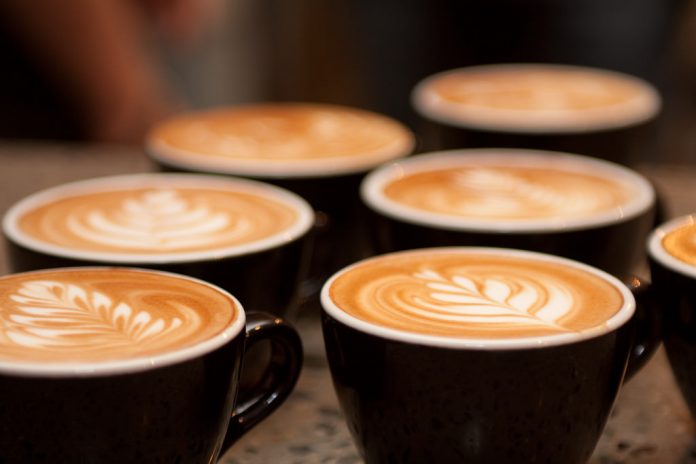Coffee kinds and brewing methods
Espresso Machine
Espresso shot:
An espresso shot comes to being by the use of an espresso machine. The machine forces a small amount of hot water under pressure to flow through finely ground espresso grinds to create an espresso shot. Espresso shots have very strong flavours, and serve as the base for many other beverages. However, espresso shots have an extremely short lifespan of around 30 seconds before they “die.” A dead shot means that the flavour of the espresso becomes extremely bitter and unpleasant.
Latte:
A latte is the go-to drink for many people because of its simplicity and diversity in flavour profiles. A latte consists of espresso that is poured into a cup, followed by perfectly steamed, velvety milk to create a sweet and creamy concoction. Baristas often show their flair by creating latte art when pouring the milk into the espresso shot. For a flavoured latte, flavour shots are added to the cup with the espresso shot, but before the milk is poured in.
Macchiato:
Depending on where in the world you order a macchiato, you can get vastly different drinks. In Italy, a macchiato consists of an espresso shot with just a tiny bit of steamed milk that is more foam than liquid, and adds just a touch of sweetness to the bold flavours of espresso. However, most coffeeshops in Canada and the U.S. take a vastly different approach to the macchiato. Instead of a small, simple drink, many coffee chains have opted for larger, more extravagant creations. These macchiatos consist of steamed milk poured into the serving cup, followed by the espresso shot, and topped with foamy milk. Having the espresso shot poured into the milk instead of into the cup first gives the espresso less time to sit and create more of a bitter flavour. However, most macchiatos are not that simple. The caramel macchiato, which is considered one of the most popular flavours for this drink style, turns a simple drink into a sugary delight. Caramel syrup is added to the cup, followed by the steamed milk, espresso, foam, and then a delightful cross-stitching pattern of caramel sauce; the perfect drink to satiate your sweet tooth.
Mocha:
The mocha is one of the go-to drinks for those who despise the taste of coffee, but need caffeine to function, and for those who can’t decide between coffee and hot chocolate. Both the mocha and its popular brother, the white mocha, are excellent choices as the sweetness of chocolate masks the taste of coffee goodness. The mocha begins with chocolate sauce (or “mocha sauce” — looking at YOU, Starbucks) added to a cup, followed by an espresso shot, and finished off with creamy steamed milk, no foam. Top it off with some heavenly whipped cream and you’ve got yourself some “coffee.”
Cappuccino:
The cappuccino is the one of the most misunderstood drinks in the world of espresso. People who are new to coffee often try a cappuccino only because the name gets thrown around in pop culture, only to be repulsed by the flavour. A cappuccino is a strong drink, as it contains less milk to soothe out the boldness of the espresso shot. It consists of an espresso shot in a cup, followed by a dash of steamed milk, and the rest of the cup is filled with steamed milk that is all foam. If you order a dry cappuccino, you are ordering a drink with an espresso shot and only foamed milk — an acquired taste.
French press:
The French press method is often revered as one of the simplest and best ways to make coffee. It allows for the most diversity for a cup of coffee as users can control the temperature, the brew time, and the grind type. What sets the French press apart from other methods of brewing is that there is no filter or other type of inhibitor that steals the essential oils from the bean, creating a fuller, more vibrant flavour, and makes the coffee feel silky smooth.
Drip coffee:
Nothing beats the convenience of a drip coffee machine. Throw some grinds into a filter, flip the on switch, and in a matter of minutes, freshly brewed coffee is ready to go. While its flavour profile compared to the other methods is debatable, it’s an easy and convenient way to produce coffee for decades.
Single-use pod machines:
Single-use pod machines have recently been sweeping across the market, as they can create a large variety of drinks in seconds, often forsaking flavour for efficiency. Keurig K-Cups, Tassimo discs, and Nespresso pods fit into their respective brand’s machines, and are only compatible with said machines, creating fierce competition. However, their convenience is now facing heavy criticisms as most of the plastic pods are non-recyclable, and are slowly starting to plug up landfills and bodies of water.
Moka Pot:
The moka pot is a two-chambered coffee machine that originated in Italy. Its funky design has made it iconic in Europe, and has seen variations of it land in modern industrial art museums. It works by boiling water in the bottom chamber. As the water begins to boil, the pressure from the steam pushes the hot water to the upper chamber. Before it completes its journey, it first must push its way through coffee grinds where it extracts the oils from the drinks. The end result is a strong flavour that is reminiscent of a mild espresso flavour.


